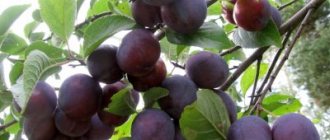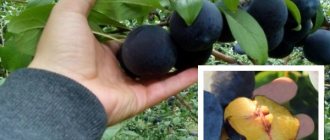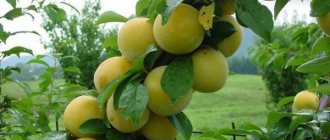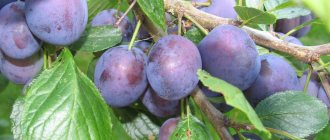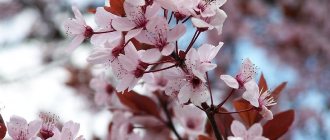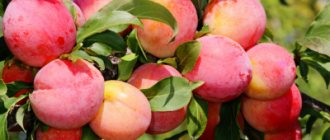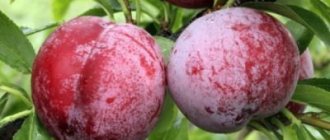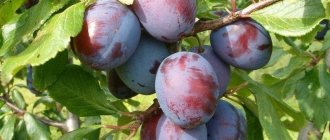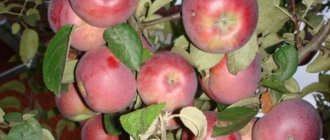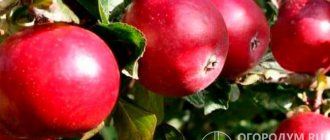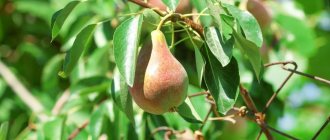Description of the plum variety Ispolinskaya
The trees are strong. After all, you need to keep large, juicy fruits on the branches. Most often they are medium-sized and reach 4 meters in height. The crown is thick, wide, and resembles a pyramid. The leaves are dark green, the flowers are white and very fragrant. Plums are ovoid in shape and take a long time to reach maturity. The fruit itself is bright red, but it has a waxy coating that looks blue on the thick skin. One fruit weighs on average 50 grams. They are elastic, and this makes it possible to use them in a very diverse way. High stability during transportation is noted. 1 hectare brings the gardener approximately 230 centners of plums! The taste depends on the region of germination. Sunny areas produce more sweetness. The variety takes root well in the central and southern regions. The pulp is very dense, juicy, does not leave the bone and is yellow in color.
Plum Stanley
| The ripening period is late-ripening, the harvest begins in the second ten days of August. The tree is medium-sized (up to 4 m) with a highly oval, compressed sparse crown. The fruits are large (up to 50-60 g), ovoid, dark purple with a thick coating. The skin is of medium thickness, the pulp is medium juicy, dense, sweet with a slight sourness. |
Fruiting occurs in the 4-5th year after planting, then annually. Flowering at the end of April.
The variety is partially self-fertile, has an average yield (up to 50 kg per tree), is resistant to polystigmosis and sharka, but not resistant to moniliosis, drought resistance and winter hardiness are average.
The fruits are resistant to cracking in wet summers and are well transportable. Recommended for fresh consumption and for processing.
Characteristics of the variety
Those who want to grow plums with high yields should familiarize themselves with the main characteristics of the Ispolinsky variety. To achieve good results, it is important to know about plum planting, tree care and disease prevention.
Drought resistance, frost resistance
The Gigantic variety is not picky. This is one of the most important advantages. Winters are not terrible, but the warmer it is, the better the plums. They are also not afraid of drought. But in the first years of the plum’s life, it will need constant watering. In winter, plums can survive frosts of -34 degrees.
Plum pollinators
The Gigantic variety does not require pollinators. It is not necessary to plant other plums near it. It begins to bloom at the end of April or beginning of May. And towards the end of August or in the first ten days of September, you can pick sweet and juicy plums.
Productivity and fruiting
The Ispolinsky variety begins to bear fruit three years after planting. This is a fairly short period of time compared to other plums. During the season, a gardener collects on average 45 kilograms of plums from one mature tree.
Area of application of berries
The Ispolinsky variety is unique in that it is used both for preparing various dishes and sweets, and for fresh consumption. Plums are sweet and juicy; they allow you to cook delicious compotes, preserves, and make marmalade.
Resistance to diseases and pests
The Ispolinsky plum variety is resistant not only to frost. The tree has the ability to resist those pests that easily attack other trees. But it is possible that this variety is also sick; in order to protect it, it is necessary to carry out preventive procedures.
Advantages and disadvantages of the variety
The advantages include high yield, early ripening, taste, transportability, and unpretentiousness. Drought and frost resistance are at a sufficient level for central Russia, but the indicators are slightly lower than some other varieties.
Harvest and storage
Harvesting begins in August, when the fruits ripen and become suitable for use. To collect and further store the plum harvest, prepare wooden boxes or baskets woven from vines. The bottom of containers for collecting food must be lined with thick paper. The fruits are laid in 4 layers to avoid strong pressure on the bottom layer. The product will keep fresh for up to 4 weeks if stored in a cool, dry place. Plums can also be stored in the refrigerator for 3–4 weeks at temperatures from 0°C to +5°C.
You will be interested to know how cherry plum differs from plum.
The Ispolinskaya plum variety is characterized by high yields and versatility of the fruit. Due to the good transportability of plums, they can be sold outside the growing region.
Landing Features
In order for a plum to produce a good harvest, it is important not only to properly care for it, but also to choose a planting site, time, and properly prepare the site. Each variety requires special conditions suitable for itself.
Recommended timing
The ideal planting time for the Ispolinsky plum variety is spring. The transplant should be done in April, when the buds begin to bloom.
Choosing a suitable location
Even before purchasing a seedling, it is important to determine where it will grow. And there are several recommendations or even rules. The place should be well lit. Shadow leads to a small harvest. It is advisable to place the tree near buildings such as a garage, summer kitchen, etc. This is due to the fact that it is important for any variety to grow in warmth, no matter how hardy it is. The north side should preferably be closed from the winds. A hole for planting would not be the best choice; you need to choose a hill or an area where there is no stagnation of water. Groundwater should not approach the root by 1.5 meters. The giant plum is not as picky about soil as cherries or cherries.
What crops can and cannot be planted nearby?
Each tree has compatibility with others. Some later carry pests, some damage with their roots, shade, and take all the nutrients from the soil. It is not advisable to plant all varieties of plum next to raspberries, currants, apple trees and pears. If elderberry and maple grow nearby, then the plum will only be better. This is a real salvation from aphids.
Selection and preparation of planting material
It is important to choose the right seedling. It is worth buying plums in trusted places, preferably with documents. The root system is what people pay attention to first. It must be developed. It is not recommended to take a seedling without a tag. There should be no spots or damage on a healthy trunk. Height – from 1 meter. It is better to take a two-year-old seedling.
Landing algorithm
In order not to damage the seedling and plant it correctly, you need to follow the algorithm:
- A post is dug into the hole, which will support the small tree.
- The pit is fertilized and soil is poured above the edges of the pit.
- Prepare the seedling and trim off the damage.
- The plum is installed so that the roots do not rest heavily on the walls of the pit.
- Water carefully so as not to damage the still weak roots.
- Yellowed leaves and straw are placed near the trunk.
Features of culture
Frost resistance. The seedlings showed excellent winter hardiness, despite the fact that the “Giant” plum was bred in a warm climate. With additional shelter, trees can withstand temperatures down to minus 34 degrees.
Moisture resistance. The official description of the “Ispolinsky” variety states that seedlings can develop correctly and produce good yields without additional watering. However, practicing gardeners note that the lack of moisture does not always go away completely for plums - most often this is reflected in the taste of the fruit.
Plum has truly “gigantic” immunity. Growing over a vast territory, representatives of this variety have managed to adapt to a wide variety of climatic regions and are able to withstand a large number of diseases and pests.
Aftercare for plums
Proper pruning of plums helps to further increase productivity, get good large fruits, and protect them from diseases and pests. Immediately after planting a young tree in the ground, approximately a third of each branch is cut off. If growth has stopped, then cut the branch to the older wood. A good time for pruning is early spring, April. This cannot be done in the fall. If complete pruning is carried out, no stumps are left. If there are a lot of fruits and they pull the lower branches down, then they should be cut off. There is no need to chase the number of branches; on the contrary, it is important to thin them out, so there will be more harvest. Weak, sluggish and damaged shoots should not remain on the tree; they are removed. Each pruning procedure is limited to one quarter of the pruned shoots. When the plum has grown 2 meters, its growth should be limited to increase the number of fruits.
Urea and potassium sulfate in quantities of 40 grams are used as top dressing in the spring. When the plums begin to fill, the substances are mixed, 30 grams of each, and fertilized. When all the fruits are ripe and have fallen, superphosphate is added in the same amount. In the fall, you cannot feed with nitrogen.
To protect against mice and hares, gardeners use special nets.
The gigantic plum loves moisture. It takes two buckets of water a day if the tree has already grown. Mid-summer is a dry time, and the fruits are filling, so at this moment you need to pay special attention to moisture. In August, watering is stopped.
During the winter, the tree is covered.
Diseases and pests, methods of control and prevention
The Ispolinsky plum variety is often affected by the following diseases:
- Clusterosporiasis.
- Moniliosis, rot.
- Rust.
- Coccomycosis.
- Sooty fungus.
- Root cancer.
- Marsupial disease.
- Milky shine.
- Silkworms are harmful.
- Goldentails.
- Sawflies.
- Hawthorns.
- Codling moths.
To prevent and treat the tree, gardeners use copper oxychloride, Bordeaux mixture 1%, and fungicide. To protect against pests, Nitrophen, Karbofos, and Benzophosphate are bred.
Description and characteristics
Columnar plums are characterized primarily by their unusual appearance, as well as their abundant harvest.
There are many varieties of this crop, the most popular of which are:
- My paradise;
- Imperial;
- Blue Sweet;
- Commander;
- Fortune;
- Arbat;
- Oscar plus;
- Mirabella.
Did you know? The columnar tree was first obtained due to a natural mutation in the 60s of the 20th century. An American breeder discovered a branch on one of the apple trees that grew vertically and was covered with fruits. This branch was propagated and used to produce a new type of apple tree. Over time, it was possible to obtain columnar forms of other fruit crops.
Trees
The peculiarities of the columnar plum tree are its small height and compactness due to the shoots that grow not to the sides, like ordinary trees, but upward, almost parallel to the main trunk.
Such trees have a narrow, underdeveloped crown and thin branches that are covered with smooth bark. The average height of the plant usually does not exceed 2.5 m. The formation of the ovary occurs on small fruit branches reaching 20 cm in length.
The yield of 1 tree ranges from 6 to 12 kg, despite the small size of the trees. During the fruiting period, the fruit branches are densely covered with plums. The columnar plum is a fast-bearing species - the harvest begins 2 years after planting.
During the first 6 years, the tree gradually grows fruit branches, and, accordingly, the amount of harvest increases. For the next 4 years, the tree has maximum yield. The plant stops bearing fruit at the age of 13–17 years, so a garden with columnar plums requires periodic renewal.
Fruits
Columnar plum fruits are of average size and weight: 1 fruit averages from 50 to 80 g, depending on the variety and growing conditions. The color of the fruit can be yellow, blue, purple, dark pink, red-brown. The shape can be spherical, round with flattened poles, or slightly elongated.
The skin is dense, so the pulp is well protected from mechanical damage. The taste is pleasant, sweet, but not cloying, with a slight sourness. The aroma is delicate, light, characteristic plum. The fruits are usually very juicy, the flesh is dense but tender, and in some varieties it is difficult to separate from the stone.
How to choose a plum: description of varieties with photos and recommended pollinators
Homemade plums (varieties and descriptions of the characteristics of trees and fruits are presented in the table) are now grown almost everywhere. Did you know that our familiar and beloved plum was grown back in the 5th century BC? e.? The first trees appeared in Egypt. Over time, breeders became interested in the crop, and now the once true southern home plum is grown almost all over the world
Choosing a suitable seedling for your plot is a rather difficult task, it is important to take into account several points, and in the “ECOgarden for everyone” project we will tell you about the main characteristics and introduce you to the most popular varieties
General characteristics
The tree is vigorous, reaches 4 meters in height, the crown is quite dense, pyramidal in shape. If we talk about frost resistance, the variety survives frosts well down to -34. It does not require pollinators, as it is self-fertile. It begins to bear fruit from the 3rd year, in the 4th year you can collect about 45 kg of fruit from one tree - the yield is high.
The fruits are very large, juicy, with a delicate aroma and sweet and sour taste, bright red in color, with thick skin and a waxy coating (as seen in the photo). The shape is obovate, weight from 45 to 60 grams. The pulp is yellow, dense, and does not separate from the seed very well, but this can be avoided if you water the tree abundantly at the end of August.
